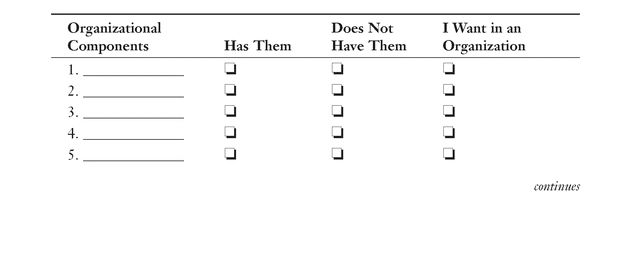Chapter 22
Diversity and Multicultural Resources
In This Chapter
• Locate multicultural educational resources
• Discover the best places to work
• Consider the importance of the work environment in choosing an organization for which to work
• Support a diverse and multicultural workforce
Do you sometimes wish that you had more resources at your fingertips that would speak directly to your needs? Perhaps you are wondering what the best companies are to work for if you are a person of color, a woman, gay or lesbian, disabled, or you are over 50. This chapter will provide some basic resources and point you to even more resources that are available to you. You will also have the opportunity to consider your career in the context of your diversity.

Career Lingo
Multicultural promotes the value of different cultures coexisting within a single society. It is a vision of cultural diversity that is deliberately fostered and protected. Multiculturalism is also known as diversity or pluralism, which means that differences among people and groups are recognized, respected, and valued.
Our global society is bringing more and more diversity to our organizations. Many of you will find yourself working in other countries as well as working alongside new immigrants to your home country. Our new working reality in a global society is pointing more and more to the important need to understand one another’s cultures. Many organizations have already begun to provide training in this area for both those employees going to work in other countries as well as for learning about the different cultures of one’s co-workers. For those who have taken advantage of these experiences, there is nothing more creative or exciting than working in a multicultural work team. When the bridges are built to understanding one another’s cultural practices, clearer communication emerges.
Finding the Right College and Financial Aid
Deciding which college to attend has been made a little easier with websites that let you put in your criteria for what you are looking for in a college education and experience. You may want to pay particular attention to the types of cultural, extracurricular, and social and service clubs available on a campus. If you are seeking a college or university environment that attracts a more diverse population, then look at the location of the school, the types of activities offered, and the demographics of a school. Here are some ideas and resources to help you in narrowing down your choice:
• Go to Peterson’s Guide at www.petersons.com and put in all your criteria for what you want in a college.
• Call the alumni office and ask to talk with recent graduates from your diverse community.
• Visit the campus and talk with current students; see for yourself how diverse the student population is and the types of services provided.
• Get a list of student organizations, fraternities, sororities, social clubs, sports teams, cultural events, and so on from the student activities office on each campus.
• Yahoo Education has a listing of colleges that specialize in education for particular cultures or groups. To access information, go to www.yahoo.com/educationand click on “By Cultures or Group” under the college section. Yahoo’s education section has many resources for college information.
Peterson’s and Yahoo also have information on financial aid. In addition to these websites, you can find scholarship and financial aid information on the following websites:
• www.CollegeData.com—has a free scholarship finder search as well as a college match system.
• www.FinAid.org—has a student profile-based, financial-aid resource.
• www.FAFSA.ed.gov—is a free application for federal student aid.
• www.AdultStudentGrants.com—has scholarship information for going back to school students.
• www.StudentAid.ed.gov—has federal student-aid information.
• www.TheOldSchool.org—offers specialized search services for minorities and women.
• www.NextStudent.com—has a scholarship search that matches your profile.
• www.NAGPS.org—is the National Association of Graduate-Professional Students and has many resources on loan consolidation, grant writing, and current issues for graduate students.
• www.FDNCenter.org—has specific grant-funding information for people with disabilities and also user aids to facilitate doing the search.
• www.UNCF.org—is the United Negro College Fund and has access to more than 7000 scholarships.
• www.HispanicFund.org—has merit and need-based scholarships.
• www.CollegeFund.org—is the site for the American Indian College Fund that awards more than 6000 scholarships.
You can also use the major search engines to input “scholarship AND your culture” to do a comprehensive search.
Finding Diversity and Multicultural Career Services
College and university student services are generally terrific places to locate people to help you to assess your career interests or work through the process with you. Many academic departments that correspond to your background often have career services specifically for a particular major. You can also try your career center, alumni office, or student services department to see whether they specialize in working with diverse populations—for example, gay, lesbian, bisexual and transsexual, African American, women, Hispanic, Asian, or the disabled.
Many websites have job search and related services. A few of these sites also have career assessment services:
• www.Diversity.com—has a career center that offers a free career evaluation and ongoing career assessment and counselor services for a fee.
• www.Monster.com—has a Diversity and Inclusion section that is in partnership with the NAACP and has links to a variety of diversity sites.
• www.quintcareers.com—is the Quintessential Careers website that has a full range of diversity resources to choose from—this is an excellent resource.

Insider Tips
If you belonged to a fraternity, sorority, or service organization with a national base, give them a call and ask whether they have recommendations for career services.
Finding the Best Places to Work
Finding the right organization to work for is key to being successful and happy in your work life. It is definitely worth your time to look into the make-up of companies you think you might want to work in before you take the leap of employment. Fortunately, for the larger organizations, you can access information on the best places to work:
• Fortune magazine puts out a yearly list of the 50 best companies for minorities including Asians, Hispanics, Native Americans, and Blacks.
• Working Mother magazine puts out a yearly list of the 100 best companies for women.
• Latina Style magazine lists the top 50 companies for Latinas and Hispanic working women.
• AARP magazine publishes a list of best companies for workers over 50.
• Hispanic Business magazine has a listing of the 500 best companies for Hispanics.
• www.HireDiversity.com has an updated listing of the most gay-friendly companies with feedback comments from people who are working or have worked in these companies.
• www.JobAccess.org powered by CareerBuilder.com provides a place where people with disabilities can seek employment, confident that they will be evaluated solely on their skills and experience.
• www.HireDiversity.com has information for all cultural groups—excellent resource.
• www.rileyguide.com/diversity has a great list of sites for all the cultural categories including indigenous and native peoples.
• www.careers.org has diversity information for cultural groups.
Any company that you work for, no matter how small or large, needs to be committed to equal opportunity for all employees. Although the government has laws that enforce this concept, look for organizations that actively recruit, train, and promote a multicultural workforce. Ask whether the organization has a values statement that represents core behaviors. Often this values statement will give you some insights into what types of behaviors are the norm in this organization. You can ask about the culture of the organization in terms of whether people work in teams, are collaborative or competitive, as well as how easy or difficult is it for new people to advance and be accepted. Find out as much as you can about how multicultural the leadership is within the organization. Ask whether they have a mentoring or coaching program within the organization.
Another terrific resource for researching the best jobs and work places is through the many organizations that have been set up as networks or resources for your particular cultural identification. There are far too many to list here, so we will give you some places to start. Remember you can do your own searches using words like networking, professional organizations AND diversity, or women, or Asians, and so on. Here are some websites to get you started:
• www.diversityworld.com is continually on the lookout for online resources that promote workforce inclusion of all people. They have affiliation and networking groups as well as all kinds of career information and support.
• www.quintcareers.com/diversity has lists of associations and networking links for all the cultural groups as well as other career resources for each group.
• www.hodesrecruitmentdirectory.com is the Bernard Hodes Group website. The Bernard Hodes Group specializes in helping organizations to become more multicultural. Even though the site is set up for organizations, it also has great resources for job seekers. Resources include best places to work, diversity newspapers and publications, and selected association lists.
Finding Help with Small Businesses
If you are thinking about running your own business, there are benefits available for minority and women-owned businesses. Some examples of the support that you can receive from the Small Business Administration (SBA) are the following programs:
• The SBA has an “On-line Women’s Business Center” (www.onlinewbc.gov) to help businesses get started and offers ongoing support. You can find information about loans and financing, training, mentor roundtables, IRS tax information, and government contracts.
• An integral component of the Entrepreneurial Development network of counseling and training services of the SBA has established The Office of Native American Affairs (www.sba.gov/naa). This program assures that American Indians, Native Alaskans, and Native Hawaiians have full access to necessary business development and expansion tools available through this agency.
• The SBA (www.sba.gov/news) has recently joined forces with the United States Hispanic Chamber of Commerce to support Hispanic Small Businesses to succeed through training, education, and access to resources. For news release, go to www.sba.gov/news for the September 16, 2004, news article.

Career Lingo
The Small Business Administration (SBA) is a government agency established to strengthen the economy by aiding, counseling, assisting, and protecting the interests of small businesses. Small businesses can receive all kinds of information on how to start a business, finance a business, and help you decide on the legal status of a business for free or at a very low cost. It is a wonderful service for small businesses. Check it out at www.sbaonline.sba.gov.
My Cultural Work Environment Preferences
Take out your Career Profile Map and look at the section on your work environment preferences. As you look over what you have already said is a priority for you in a work environment, consider whether there are any other additions based on your cultural background. There are no rules about having preferences based on your cultural background.
Some of us like being the “only” person who is like me (a woman, black, Hispanic, Asian, has a disability, is over 50). On the other hand, many of us want to have a few other people around that are like you. The benefits to this include not having to be the only representative of your group, not standing out as much, not being as visible or having the pressure to perform above and beyond the norm because you stand out. In addition, it’s great to have other people in your organization who have similar cultural backgrounds. This adds to some people’s comfort level, and many times is an enhanced support network within the organization.
So the question for you here is how important is it to you to be in a multicultural work environment? This will help to guide you in researching information on demographics of organizations you are applying to as well as to guide your decision making.
The other aspects to consider are what the organization has to offer in terms of mentoring and coaching programs, orientation to the culture, and continued guidance in maneuvering in that culture, training programs on communicating across cultures for everyone in the organization, specialized training programs for diverse employees, access to continued training, advancement opportunities, and so on.
Make a little organizational matrix to assess how well each organization you look at is matching your particular needs:


Supporting a Multicultural Workforce
We are all part of the multicultural workforce that exists in many companies today. Beyond the workplace, we are citizens of our community, our neighborhoods, our country, and our world. The globalization of business is increasing everyday, and with this globalization our multicultural make-up is increasing.
Some of us are students of the world, and we learn very easily about other cultures. Still others of us may have grown up in one culture, with very little exposure to other cultures.
Part of the continuous learning that is going to become more standard in our organizational lives is the fact that we have to learn more about other cultures in order to do business of any kind. Here are some ways you can begin this journey:
• Find out what programs your organization offers that engage you in learning about other cultures.
• Take an assignment to another country and immerse yourself in learning their culture, their language, and their way of communicating.
• Read autobiographies and biographies of people from different cultures.
• Watch PBS (public broadcasting system) or TV programs on other networks about different cultures.
• Travel to other countries on vacation.
• Stay with families in other countries for a few weeks.
• Read books about culture. Check out www.journeyinlife.com for suggested readings from Dr. Jean Kim.
• Look for lectures at local colleges on cultures.
• Go to festivals put on by cultural groups in your community.
• Request that your organization do a staff development or training program on getting to know one another’s cultures.
Whatever our situations, there is room for learning more about one another and increasing our ability to work together in collaboration, harmony, and hopefully joyfully!
The Least You Need to Know
• When you are looking for great matches in colleges and organizations to match your career profile, look up information on financial aid and scholarships for members of your cultural group.
• Look to your college career center and alumni office for diversity resources and then check out websites that have assessment services: www.Diversity.com, www.Monster.com, and www.quintcareers.com.
• Minority- and women-owned businesses can receive great support from the Small Business Administration, and there are benefits available in obtaining government contracts for minority- and women-owned businesses.
• As a member of the multicultural workforce, we all have access to educational and learning events and resources that can help us to be a productive member of our multicultural work teams and organizations.
• It’s important to consider the types of organizational climate and support that organizations have for promoting and maintaining diversity. Look at organizational policies around recruitment, retention, and development.
..................Content has been hidden....................
You can't read the all page of ebook, please click here login for view all page.
